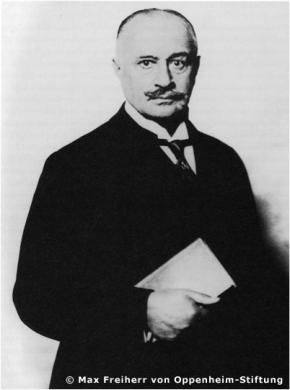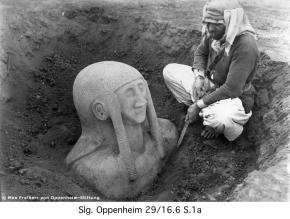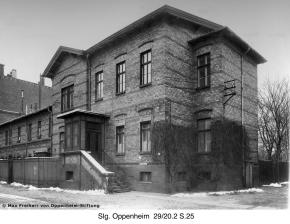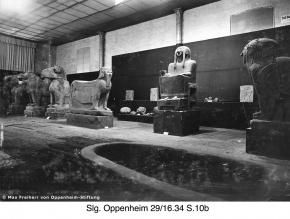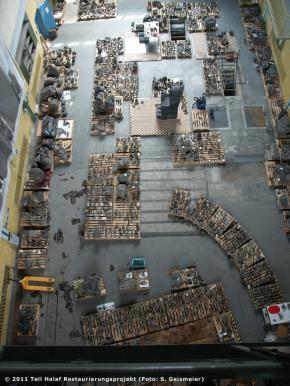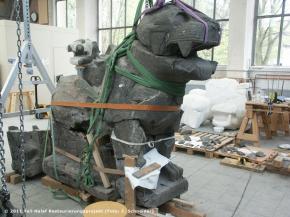Research historyDr. Lutz MartinThe recent research looks back upon a series of earlier investigations that began with the first expeditions of the traveler Max Freiherr von Oppenheim, who discovered the site during a journey through Syria, upper Mesopotamia and southeastern Anatolia. About Max Freiherr von Oppenheim
The site of Tell Halaf was discovered in 1899 by Max Freiherr von Oppenheim (1860-1946), a descendant of rich Cologne bankers (Fig. 1). At the time, Oppenheim was employed as an attaché at the Imperial Consulate General in Cairo. The discovery of Tell Halaf (1899)
Hints from the local population turned his attention to Tell Halaf, where sculptures had appeared in a style hitherto unknown. In the absence of a licence to excavate, Oppenheim had to immediately refill the soundings which he had made and where sculptures had already been exposed. The first season (1911-1913)
It took until 1911, before Max von Oppenheim, who had left the diplomatic service, was able to return and to start excavating at Tell Halaf (Fig. 2). The undertaking continued until 1913 without interruption; and was funded from his private fortune, originating from his paid-out inheritance. The excavations had to be discontinued due to World War I and the economic troubles it caused. The return to Tell Halaf (1927) and the last season (1929)
It was not before 1927 that Max von Oppenheim was able to return to Tell Halaf in order to salvage the sculptures deposited in his expedition-house, which had been destroyed in 1920/21.
In 1929, a further excavation campaign took place – the last one, for the time being. There were plans to resume excavations in 1939, but in the face of the political situation before the start of World War II, they were never conducted. Building the private Tell Halaf-Museum in Berlin Charlottenburg
In the following years, Max Freiherr von Oppenheim and his collaborators were busy evaluating their findings and making the finds accessible to the public (Fig. 3-4). To that purpose, a former workshop of a machine factory left to his use by the Technische Universität Berlin was remodelled in 1930 to house the Tell Halaf–Museum. Meanwhile the directorate’s building next door was turned into a research institute. Both houses were badly hit during the allied bombardments of 1943 and large parts of them were destroyed. Walter Andrae, at that time director of the Vorderasiatische Abteilung der Staatlichen Museen zu Berlin, had the basalt fragments of the finds that had been on exhibit salvaged from the ruins of the museum. It was only quite recently that the restoration of sculptures, architectural stones, stone implements and stone vessels from more than 27,000 fragments was tackled (www.tell-halaf-projekt.de). Publications of the first results
The archaeological results were published in a preliminary report (»Vorbericht«, 1931) and in four volumes of the final publication (from 1943 to 1962). The texts were published in another monograph (1941). The preparation of the final publication suffered considerably from the destruction of the Tell Halaf Museum, as large parts of the documentation had been destroyed as well. Only the first volume about the prehistoric finds had been completed before the bombardment of the museum and while Oppenheim was still alive. R. Naumann, who edited the volume on architecture in 1950, was forced to base his interpretation of the findings’ building-history on that of F. Langenegger, excavation architect in Tell Halaf, whose field diary had been preserved while his original drawings were lost. Because the find lists were lost as well, it was not possible to date the levels by objects found within them. In 1955, A. Moortgat presented the sculptures from Tell Halaf; when the preliminary report was published, knowledge about the development of north-Syrian sculpture had grown considerably since 1931, and consequently, he was in a position to correct the early date of the sculptures proposed by M. von Oppenheim and E. Herzfeld. B. Hrouda, who edited the volume on the small objects in 1962, did not have the find lists at hand, either; therefore levels and small objects are only rarely correlated. Tell Halaf in research
Despite the drawbacks of the final publications resulting from the difficulties at the outset, those volumes formed, in the succeeding decades, the basis of a lively scientific discussion on the finds and findings from Tell Halaf. Especially the date of the sculptures was the topic of several controversies. To this day, Kapara of Guzana, the ruler who had the sculptures incorporated in his buildings, is dated anywhere between 950 and 800 B.C. Among the small objects, especially the ivories aroused the attention of several scholars. Restoration project
Up until the early 1990’s the fragments of the sculptures from the Tell Halaf Museum, which had been hit by a Phosphor-bomb in November 1943, were stored in the cellar of the Pergamonmuseum in Berlin. All limestone-orthostats and gypsum-casts had gone up in flames and the hot sculptures of basalt had exploded upon contact with water meant to extinguish the fire. After the two German states were reunited, a first systematic look at the remains made it clear that it would be possible to restore some of the sculptures (Fig. 5-6).
In the course of nine years from 2001 to 2010, all sculptures from the old Tell Halaf-Museum have been put back together from more than 27,000 fragments. Thus, they have become accessible to the public and researchers once more. In January 2011, the results of the restoration project were presented to the public in the exhibition "Die geretteten Götter aus dem Palast vom Tell Halaf" (http://www.gerettete-goetter.de) at the Pergamonmuseum. (Translation: B. Finkbeiner / A. Sollee / B. Sollee) |





